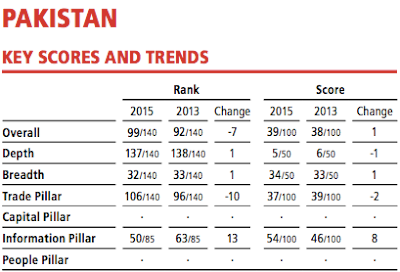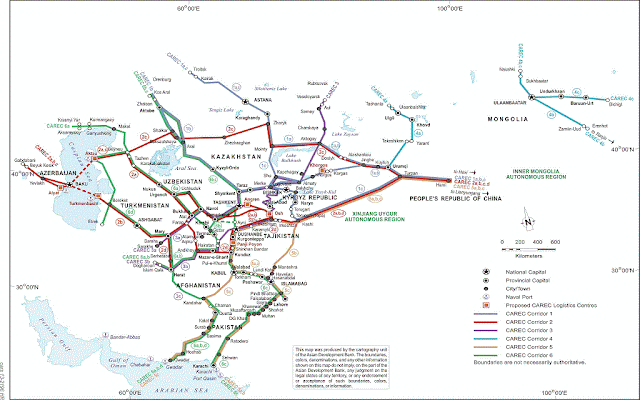PakAlumni Worldwide: The Global Social Network
The Global Social Network
Globalization Index: How Connected is Pakistan?
Pakistan ranks 32nd in breadth and 99th overall among 140 countries in terms of globalization, according to DHL Global Connectedness Index compiled by professors at NYU Stern School of Business and IESE Business School. Pakistan ranks 137 on depth and 32 on breadth among 140 countries as measured in 2015. Pakistan's neighbor India ranks 133 on depth and 21 on breadth. The report blames relatively higher breadth than depth on poor levels of regional integration, depressed in particular by the animosity between South Asia’s two largest economies, India and Pakistan.
Four Pillars of Globalization:
The index is based on international flows of trade, capital, information and people. The index measures the parameters on depth and breadth. Depth evaluates the extent to which countries' international flows are distributed globally or more narrowly focused, while breadth compares countries' international flows to the sizes of their domestic economies.
Pakistan ranks 137 on depth and 32 on breadth among 140 countries as measured in 2015. Pakistan's neighbor India ranks 133 on depth and 21 on breadth. The lowest ranked countries on the depth dimension are Iran, Bangladesh, Burundi, Pakistan, Nepal, Myanmar, Ethiopia, India, Indonesia, and Egypt.
South Asia Lags in Globalization:
The DHL report says that South and Central Asia region lags across nearly all aspects of global connectedness. This region ranks last on depth and third from last on breadth. Furthermore, its relatively higher breadth than depth is a reflection of the poor levels of integration within the region, depressed in particular by the animosity between South Asia’s two largest economies, India and Pakistan.
SAARC or CAREC Regional Integration:
Pakistan sits between two economically very dynamic regions: Central Asia (and Western China) and South Asia. Which region is better suited for its economic connectivity and integration? Should Islamabad focus on CAREC (Central Asia Regional Economic Cooperation) rather than SAARC (South Asian Association of Regional Cooperation)?
Ideally, Pakistan should be a major player in both vibrant regions. However, Indian Prime Minister Narendra Modi's policy of attempting to isolate Pakistan has essentially forced it to choose.
First, Mr. Modi decided to boycott last year's SAARC summit that was scheduled to take place in Islamabad, Pakistan. Then, he unsuccessfully attempted to hijack the BRICS economic summit in India to use it as a political platform to attack and isolate Pakistan. The signal to Pakistan was unmistakable: Forget about SAARC.
Central Asia Regional Economic Cooperation (CAREC):
CAREC is a growing group of nations that is currently made up of 11 members, including China and a list of STANs. The current membership includes Afghanistan (joined CAREC in 2005), Azerbaijan (2003), People's Republic of China (1997), Georgia (2016), Kazakhstan (1997), Kyrgyz Republic (1997), Mongolia (2003, Pakistan (2010), Tajikistan (1998), Turkmenistan (2010) and Uzbekistan (1997).
The 2016 ministerial meeting of CAREC nations was held in Islamabad. The conference theme was “Linking connectivity with economic transformation".
Welcoming fellow ministers, Pakistan's then Finance Minister Ishaq Dar talked about the importance of the China-Pakistan Economic Corridor (CPEC) to improve trade flow within the region and with the rest the rest of the world.
Dar said CPEC offered a massive opportunity for connectivity between Central Asia, Middle East and Africa and was bound to play a defining role in economic development of the regions. Dar said improving the transport corridor was not an end in itself but it was an investment in establishing sound infrastructure and complementary frameworks for shared prosperity of the present and future generations in the region, according to a report in Pakistani media.
CAREC Corridors:
CAREC region is building six economic corridors to link Central Asian nations. Six multi-national institutions support the CAREC infrastructure development, including the Asian Development Bank (ADB), United Nations Development Program (UNDP), International Monetary Fund (IMF), World Bank, Jeddah-based Islamic Development Bank and European Bank for Reconstruction & Development, according to Khaleej Times.
Out of the total $27.7 billion CAREC infrastructure investment so for, $9.9 billion or 36 per cent was financed by ADB, a senior officer of the Manila-based multinational bank told Khaleeej Times.
He said other donors had invested $10.9 billion while $6.9 billion was contributed by CAREC governments. Of these investments, transport got the major share with $8 billion or 78 per cent. Asian Development Bank Vice President Wencai Zhang said: "There are huge financing requirements in Carec for transport and trade facilitation, for which 108 projects have been identified at an investment cost of $38.8 billion for the period 2012-2020. Investment for the priority energy sector projects will be $45 billion in this period."
CPEC North-South Corridor:
China Pakistan Economic Corridor (CPEC) is a major part of the north-south corridor that will allow trade to flow among CAREC member countries, many of which are resource-rich but landlocked nations. The corridor will enable the group to access to the Pakistani seaports in Gwadar and Karachi as part of the new maritime silk route (MSR) as envisioned by China and Pakistan.
Pakistan's Finance Minister Dar says the CPEC would complement the regional connectivity initiatives of CAREC. "Once the six CAREC corridors and mega ports, now under construction, start operating, they will provide access to global markets. They will deliver services that will be important for national and regional competitiveness, productivity, employment, mobility and environmental sustainability. All of us should gear our national policies to achieve these targets."
CPEC consists of transport and communication infrastructure—roads, railways, cable, and oil and gas pipelines—that will stretch 2,700 kilometers from Gwadar on the Arabian Sea to the Khunjerab Pass at the China-Pakistan border in the Karakorams.
China and Pakistan are developing plans for an 1,800 kilometer international rail link from the city of Kashgar in the Xinjiang Uygur autonomous region in Western China to Pakistan's deep-sea Gwadar Port on the Arabian Sea, according to Zhang Chunlin, director of Xinjiang's regional development and reform commission.
"The 1,800-kilometer China-Pakistan railway is planned to also pass through Pakistan's capital of Islamabad and Karachi," Zhang Chunlin said at the two-day International Seminar on the Silk Road Economic Belt in Urumqi, Xinjiang's capital, according to China Daily.
"Although the cost of constructing the railway is expected to be high due to the hostile environment and complicated geographic conditions, the study of the project has already started," Zhang said. "China and Pakistan will co-fund the railway construction. Building oil and gas pipelines between Gwadar Port and China is also on the agenda," Zhang added.
Afghan Instability:
Pakistan is making a serious effort to stabilize Afghanistan, a member of CAREC. Trilateral conferences of China, Russia and Pakistan support this effort. Afghan instability has prevented Pakistan from connecting with other STANs for commerce and trade. Now the development of CPEC will enable Pakistan to bypass Afghanistan, if necessary, to connect with Central Asia region through Western China.
Summary:
Pakistan ranks 32nd in breadth and 99th overall among 140 countries in terms of globalization, according to DHL Global Connectedness Index compiled by professors at NYU Stern School of Business and IESE Business School. Pakistan ranks 137 on depth and 32 on breadth among 140 countries as measured in 2015. Pakistan's neighbor India ranks 133 on depth and 21 on breadth. The report blames relatively higher breadth than depth on poor levels of regional integration, depressed in particular by the animosity between South Asia’s two largest economies, India and Pakistan.
History shows that growth of regional and global trade in East Asia, Europe and North America regions has been a major driver of economic opportunity and prosperity. Unfortunately, SAARC has been a huge disappointment for Pakistanis. With the development of CPEC and CAREC, Pakistan can now begin to participate in the growth of regional and global trade that will benefit the people of Pakistan. The path to Pakistan's participation in SAARC will open up if or when India-Pakistan relations improve.
Here's a National Geographic Documentary on CPEC:
Related Links:
China Pakistan Economic Corridor
CPEC to Create Over 2 Million Jobs
ADB Raises Pakistan GDP Growth Forecast
China-Pakistan Industrial Corridor
Indian Spy Kulbhushan Yadav's Confession
-
Comment by Riaz Haq on July 17, 2021 at 4:27pm
-
#US, #Afghanistan, #Pakistan, #Uzbekistan to form quad group to enhance regional connectivity for #rade, #transit links. The new quad group is important amid #China's desire to extend its Belt Road Initiative (BRI) to Afghanistan. #BRI #CPEC #SilkRoad https://www.thehindu.com/news/international/us-afghanistan-pakistan...
The US, Afghanistan, Pakistan and Uzbekistan have agreed in principle to establish a new quadrilateral diplomatic platform focused on enhancing regional connectivity, the Biden administration has said.
“The parties consider long-term peace and stability in Afghanistan critical to regional connectivity and agree that peace and regional connectivity are mutually reinforcing,” the State Department said on Friday.
Recognising the historic opportunity to open flourishing interregional trade routes, the parties intend to cooperate to expand trade, build transit links, and strengthen business-to-business ties, it said.
“The parties agreed to meet in the coming months to determine the modalities of this cooperation with mutual consensus,” said the State Department.
Afghanistan’s strategic location has for a long time been touted as a competitive advantage for the country. Afghanistan is bordered by Pakistan to the east and south, Iran to the west, Turkmenistan, Uzbekistan, and Tajikistan to the north, and China to the northeast.
Located at the heart of the historic Silk Road, Afghanistan was long the crossroads of commerce between Asian countries connecting them to Europe, and enhancing religious, cultural, and commercial contacts.
The formation of the new quad group is important amid China's desire to extend its Belt Road Initiative (BRI) to Afghanistan.
The BRI, a multi-billion-dollar initiative launched by Chinese President Xi Jinping when he came to power in 2013, aims to link Southeast Asia, Central Asia, the Gulf region, Africa and Europe with a network of land and sea routes.
By virtue of its location, Afghanistan can provide China with a strategic base to spread its influence across the world.
Since the announcement of the withdrawal of U.S. forces by August 31, violence has been rising and efforts to broker a peace settlement between the Afghan government and insurgent Taliban have slowed.
Comment
Twitter Feed
Live Traffic Feed
Sponsored Links
South Asia Investor Review
Investor Information Blog
Haq's Musings
Riaz Haq's Current Affairs Blog
Please Bookmark This Page!
Blog Posts
IMF Questions Modi's GDP Data: Is India's Economy Half the Size of the Official Claim?
The Indian government reported faster-than-expected GDP growth of 8.2% for the September quarter. It came as a surprise to many economists who were expecting a slowdown based on the recent high-frequency indicators such as consumer goods sales and durable goods production, as well as two-wheeler sales. At the same time, The International Monetary Fund expressed doubts about the Indian government's GDP data. …
ContinuePosted by Riaz Haq on November 30, 2025 at 11:30am
Retail Investor Growth Driving Pakistan's Bull Market
Pakistan's benchmark index KSE-100 has soared nearly 40% so far in 2025, becoming Asia's best performing market, thanks largely to phenomenal growth of retail investors. About 36,000 new trading accounts in the South Asian country were opened in the September quarter, compared to 23,600 new registrations just three months ago, according to Topline Securities, a brokerage house in Pakistan. Broad and deep participation in capital markets is essential for economic growth and wealth…
ContinuePosted by Riaz Haq on November 24, 2025 at 2:05pm
© 2025 Created by Riaz Haq.
Powered by
![]()



You need to be a member of PakAlumni Worldwide: The Global Social Network to add comments!
Join PakAlumni Worldwide: The Global Social Network